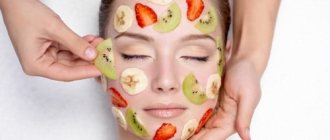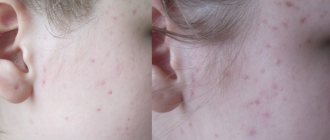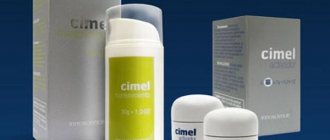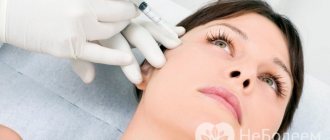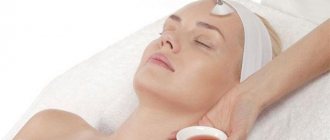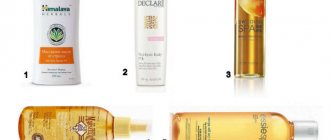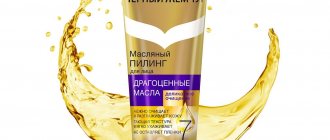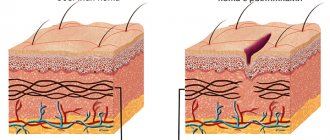Phytin peeling - what is it?
Phytin peeling is a procedure that is used to eliminate fine wrinkles, age spots, superficial scars and stretch marks. The main active component of a special cosmetic composition is phytic acid. Its molecules are large, therefore they do not penetrate into the deep layers of the dermis, but exert their influence exclusively on the superficial epidermis.
Phytic acid reduces melanin synthesis, depigmentes and brightens the skin, normalizes the functioning of the sebaceous glands, stimulates the synthesis of collagen fibers, tightens pores, and gently cleanses impurities. Rice and wheat cake is especially rich in its content.
Special compositions for phytic peeling are combined with tartaric acid, and in some cases glycolic or succinic acid. They are selected taking into account individual sensitivity and the expected effect. Tartaric acid is good for treating age spots, while glycolic and succinic acids have excellent moisturizing properties.
Difference of procedure
Phytic acid, as the main active component of some superficial peeling products, has long earned recognition from professional cosmetologists and trust among their patients. In nature, this beneficial ingredient is found in the seeds of wheat, rice, legumes and oilseeds, as well as in several vegetables. In cosmetology, it forms the basis of the phytin peeling procedure of the same name.
Upon contact with the skin, phytic acid reaches the cells of its second - epidermal - layer, where the natural decomposition of this organic compound has a beneficial effect on the tissue. As a result of this interaction, the skin structure is aligned and restored from the inside, blood flow is stimulated, cells receive sufficient nutrition and oxygen, and the functioning of the sebaceous glands is normalized.
It is impossible to achieve such an effect with creams, serums or other, albeit effective, but still superficial facial care products, because their action is limited to the first layer of skin - the dermis.
The properties of phytic acid give peeling a powerful anti-inflammatory and antioxidant effect, which helps even out skin color. This exfoliation increases the immunity of epidermal cells, simultaneously awakening them to increased production of collagen and elastin.
Innovative peeling with phytic acid has a second name, common among some salons – “Hollywood”. He came to the Russian beauty industry from the USA.
American show business stars value this type of peeling for its relevance and the ability to perform it even in late spring or summer. Plus, unlike other types of chemical peels, the procedure has a short recovery period. The consequences of phytin peeling can be easily corrected with decorative cosmetics: the very next day after the session you can appear in public and work, even if you are a fashion model.
Today, almost all cosmetology clinics and professional beauty salons offer phytin-based peeling procedures. Often, mainly to achieve a cleansing and brightening effect, glycolic and tartaric acids can be added to it in high percentage concentrations. But this does not reduce the safety of the procedure, but, on the contrary, increases its effectiveness. If visiting beauty salons is expensive or you don’t have time, “Hollywood peeling” can be done yourself at home.
Among the undoubted advantages and distinctive features of phytin peeling, experts highlight:
- softness and safety of the procedure for any skin type;
- year-round phytin cleansing – peeling sessions can be carried out even in the summer season;
- simultaneous achievement of a rejuvenating and brightening effect by stimulating the production of collagen, elastin and suppressing the hormone responsible for hyperpigmentation;
- the possibility of prescribing the procedure even with rosacea;
- the ability to carry out peeling yourself at home;
- the procedure is painless and there is no long-term recovery (almost one-day rehabilitation);
- no need for complex post-peeling care.
Who is Hollywood phytin peeling suitable for?
Despite the fact that this chemical peeling came from the USA, it has proven itself well in our climate. It can be done regardless of the season, both winter and summer.
Indications for use
- Photoaging. Acting primarily on the superficial layers of the dermis, this type of peeling gently exfoliates the skin of exposed parts of the body that is dry due to ultraviolet rays (suitable for the face and hands).
- Hyperpigmentation. Reducing the synthesis of melanin and active interaction with its granules located in epithelial cells allows you to quickly lighten the skin and reduce the size and shape of age spots.
- Problems of mature skin and rosacea. This peeling has a pronounced anti-aging effect; suitable for problem skin; fights early wrinkles; It eliminates spider veins and spider veins well, which makes it indispensable for rosacea.
- Striae. Phytic acid stimulates connective tissue cells - fibroblasts, which in turn activate the synthesis of elastin and collagen. Increasing the elasticity of the skin allows you to smooth out superficial wrinkles and also remove stretch marks.
- Superficial skin scars. Phytic acid penetrates only into the stratum corneum of the skin, so even at the highest concentration of 50% and the longest exposure of 15 minutes, the deep layers of the dermis will not be exposed to its action. Superficial scars will thin out and practically disappear, but deep ones, unfortunately, will remain.
Phytin peeling and contraindications
Despite the safety of using phytic acid, phytic peeling does not have clinically proven protocols for the safety of this procedure. It is not yet certified or permitted in the Eurozone countries.
Contraindicated in the following cases:
- Allergy to phytic acid or components of the composition. In this case, you should choose a different type of peeling. Persons with hypersensitivity should also take similar advice.
- Pregnancy and breastfeeding. The active components, penetrating the mother’s bloodstream, enter all organs and tissues with the bloodstream. Their effect on the development and growth of a child has not been clinically proven, but it has not been refuted either, so you should refrain from procedures for this period.
- Molluscum contagiosum. Before starting a peeling course, you should be treated by a dermatologist, otherwise contamination of uninfected skin may occur.
- Herpes virus infection. It is necessary to wait for complete recovery and stable remission in order to begin the procedure.
- Minor wounds, abrasions. Peeling can support the inflammatory process with further formation of deep skin scars.
- Oncological diseases. Any oncological process, regardless of type, type and stage, is a strict contraindication. Peeling can serve as a trigger for their growth or malignant degeneration.
- Eczema and psoriasis. The effect of phytic acid on affected areas of the body can lead to complications of the underlying disease.
- Diabetes. Increased fragility of blood vessels and the formation of hematomas make it impossible to carry out this procedure, since the risk of adverse reactions is higher than the expected effect.
- Cardiac, pulmonary, renal failure. Even a slight external influence (not to mention the peeling itself) can significantly worsen the condition and cause death.
- Manifestations of hypersensitivity to the components of the peeling composition.
Persons with hypersensitivity to the components of the drug may experience the following reactions:
- Active peeling that goes away within 3 days.
- Redness (erythema) in the area of application of the composition for 4 hours.
- Severe non-inflammatory swelling of the face, which decreases after 4-5 hours.
- Exacerbation of herpes virus infection, manifested in the form of skin rashes.
Who needs phytin peeling and when?
Phytin peeling is suitable for all ages and skin types. Unlike other chemical exfoliation, such as medium or deep, this gentle superficial technique affects only the stratum corneum of the epidermis.
This method of restoration and rejuvenation of appearance is suitable even for those with sensitive or rosacea-prone facial skin. And for those who suffer from constant oily shine, flaking or painful pallor, it will be ideal.
So, phytin-based peeling is necessary for:
- inflammatory and infectious processes on the face;
- noticeable scars and stretch marks;
- age and solar pigmentation;
- increased oily skin;
- the appearance of a network of facial wrinkles;
- age-related changes in the face: deep wrinkles, signs of aging;
- aesthetic problems with enlarged and contaminated pores;
- acne as part of complex therapy;
- the first signs of photoaging;
- dry skin;
- the appearance of keratomas against the background of excessive tanning in a solarium or on the coast;
- preparation for further anti-aging cosmetic procedures, such as microcrystalline dermabrasion or laser resurfacing.
How is phytin peeling done?
The protocol for the phytin peeling procedure differs little from other types and consists of the following steps:
- Removing dirt and makeup.
- Application of a peeling composition containing phytic acid.
- The use of soothing masks and tonics.
- Using special restorative creams with retinol, tocopherol, hyaluronic acid.
It should be noted that cosmetologists recommend pre-peeling preparation with gels with glycolic or compositions with 15% mandelic acid. Apply to cleansed skin once a day for 7 days.
Benefits and results of phytin exfoliation
The most important effect of a correctly performed phytin exfoliation procedure will be deep cleansing of the skin from dead cells. This will allow the skin to breathe, fully absorb oxygen molecules, establish metabolism and replenish the lack of collagen and elastin fibers. A gentle and at the same time safe phytin peeling procedure returns youth, elasticity and even color to the skin, and freshness and attractiveness to the face.
In addition, the undeniable advantages of such a superficial peeling procedure will be:
- noticeable reduction in the network of facial and age wrinkles;
- narrowing of enlarged pores and their deep cleansing;
- reducing the level of sebum secretions due to the normalization of the sebaceous-sweat glands;
- lightening of sun and age-related pigmentation by neutralizing the enzyme tyrosinase;
- launching natural regeneration processes in the lower layers of the epidermis;
- absence of complications and long-term rehabilitation after peeling;
- therapy of inflammatory processes in the area affected by phytic acid;
- smoothing small scars, reducing stretch marks;
- reducing the manifestations of acne;
- deep and long-lasting skin hydration.
The result of 4-6 phytin peeling procedures, performed either by a professional cosmetologist or independently at home, lasts on average up to 3 months. Then the course of rejuvenation sessions can be repeated. Moreover, they do not cause any discomfort and are easy to carry out.
How to carry out phytin peeling at home?
Professional peeling can only be performed in a salon by a qualified specialist. However, the high price of each procedure prompts the search for an alternative, cheaper option.
A recipe for phytic peeling carried out at home should begin with the words: “you need to purchase a product containing phytic acid as a monocomponent or as a combination, such as an almond-phytin composition...”.
In order for the desired effect to be achieved, pre-peel preparation is carried out with compounds containing mandelic or glycolic acid for a week. Before directly applying the peeling composition, use a special lotion with alpha and beta hydroacid. Then carefully apply the main product with phytic acid in one layer to the skin, with the exception of the area around the eyes.
After 10 minutes, everything is washed off with regular warm water, since phytin peeling does not require special neutralization. After the procedure, apply a restorative cream with retinol, panthenol or hyaluronic acid.
Contraindications for peeling
For all its versatility, phytin peeling has a number of limitations. You will have to choose a different cleaning option if you have certain conditions:
- papillomas;
- diabetes;
- eczema;
- herpes in the active stage;
- molluscum contagiosum;
- secondary infections.
Peeling is also prohibited during pregnancy, cancer, unhealed skin lesions and serious dysfunction of internal organs.
In addition to a fairly extensive list of contraindications, the procedure has several other disadvantages.
- High price.
- Inability to eliminate serious defects.
- Insufficient knowledge of the effect of phytic acid on the human body.
In some countries, phytin peeling is prohibited, but not because it is harmful to health. In this way, the authorities are trying to protect women from possible negative consequences that no one has experienced yet.
How many phytin peeling procedures should be done to see results?
The first results will be noticeable after the first procedure: the skin will acquire a healthy color, firmness and elasticity, and the number of age spots and spider veins will significantly decrease. However, in order to consolidate the effect, you will have to meet with a cosmetologist 4 to 8 times during 1 course of therapy. Procedures are carried out once a week, their number is determined by a specialist.
PROCEDURE PROTOCOL
The stages of the procedure for home use are standard:
- We cleanse the face with a preparation containing weak fruit or salicylic acid;
- Apply the preparatory agent (glycolate) for 10 minutes;
- Cover the face with phytic acid (20-50%) in an even layer;
- For beginners, leave for 3-5 minutes, for intermediates - for 10-15 minutes;
- Wash off with water;
- We tone again;
- Soothe the skin with a mask and then cream.
The session lasts 30-40 minutes.
Important! You should not increase the exposure time to more than 15 minutes. After this time, keratinocytes (forming the protective layer of the cell) begin to break down.
Getting ready for the session
In order for the face to be better prepared for phytin exfoliation, dermatologists recommend leveling the surface of the epidermis in advance. To do this, for 1 week .
Almond exfoliants have also proven themselves well: it has been scientifically proven that a 15% concentration of an extract from this nut makes the phytin treatment procedure the most effective.
If the goal is to get rid of hyperpigmentation, the preparatory period with the use of acids increases 3 times: up to 3 weeks .
For the first time, exposure to glycolic-almond exfoliants should be minimal: 6 minutes , and then the time can be increased to 10 minutes.
Mediccontrolpeel NeoStrata
Rehabilitation
To ensure that the healing process goes smoothly and new collagen-elastin fibers are fully formed, you need to remember the “Bible” of post-peeling care - SPF 35+ photo filters, preparations with panthenol, as well as moisturizing and nourishing creams (for example, with hyaluron).
We recommend: 11 FACIAL EXFOLIANTS of different consistencies
Creams with shea butter, cyramids and wax, placental milk and antioxidant drugs will also help prevent dehydration and complexion disorders. For 30 days, it is better to limit any stress on the skin.
ceramides beeswax
Care after the procedure will not only protect against the negative effects of the environment, but also prevent the formation of scars. For the same reasons, under no circumstances should you use scrubs or aggressively rub anything into the fabric during this period.
How often to exfoliate
The effect of phytin treatment is immediately visible.
Rezu ltate after a course (3-8 sessions) lasts 3-6 months , depending on skin type.
It is necessary to take breaks between procedures:
- Depending on the concentration of acids in the exfoliant, intervals can be from 1 day to 2 weeks .
- If we are talking about a one-component phytin preparation, sessions can be carried out every 3-7 days.
Negative consequences
Due to the special delicacy of phytic acid, complications with such cosmetic treatment are very rare and, as a rule, are associated with individual intolerance or hypersensitivity:
- Dehydration;
- Redness (erythema) lasting up to 3 hours;
- Light peeling for 2 days;
- Swelling due to activation of anti-inflammatory mediators;
- Activation of herpes;
- Infections caused by streptococci and staphylococci due to disorders; hygiene;
- Allergy.
To avoid such unpleasant surprises, it is worth doing a pre-procedure allergy test on the forearm or elbow, and also follow the rules of care after the session.
For swelling and redness lasting more than 3 days, a dermatologist can prescribe anti-inflammatory drugs like Voltaren or Traumeel; Baneocin is prescribed to treat infections; allergies disappear with a single use of Erius.
LANCER PHARMIKA RENEW PLAYANA
Which peel to choose: phytin or glycolic?
Phytin peeling is gentle and acts exclusively on the cells of the stratum corneum of the skin, gently and efficiently exfoliating them. It has virtually no side effects and is an effective procedure, especially for rosacea. Its use is justified in people with oily and problem skin. The disadvantage of phytin peeling is its price and insufficient clinical research base for its safety.
Glycolic peeling not only cleanses the skin, but also actively moisturizes it. It is actively used in people with dry and sensitive skin. Compared to phytin, it is cheaper and can be easily used at home. If you still have doubts about choosing the type of peeling, you should consult with a cosmetologist who will help you choose a course of procedures according to the individual characteristics of your skin.
Properties of phytic acid
In addition to the fact that this type of acid has a delicate, but at the same time quite deep cleansing and exfoliating effect, it is also unique in that it inactivates the tyrosinase enzyme. It is because of the excessive production of the latter that hyperpigmentation appears.
The brightening, antioxidant and anti-inflammatory effects of phytic acid are clearly expressed after the first use of this drug. Even a very high concentration of this acid is not capable of causing damage to the soft tissues of a person’s face. This acid consists of rather large molecules that cannot penetrate into the very depths of the skin and linger only in its stratum corneum.
To date, phytic acid peeling has not yet been studied by the Ministry of Health. But Israeli dermatologists, after conducting preliminary studies of phytic acid, found that it has anti-cancer properties, expressed by:
- in suppressing vascular growth;
- in suppressing cell division;
- in increased apoptosis – “cellular suicide”;
- with pronounced antioxidant properties.
Real reviews about phytin peeling
Phytin peeling is the most gentle of all such procedures, really! It doesn’t pinch or bake anything, either during or after it. Usually, after peeling the face with another acid, I had to pee at work at my own expense, since my face was red. But the most important thing is that it is effective!
I will attach my photos before and after the procedure:
I only went to see it once, and already the acne marks are almost invisible. In addition, the wrinkles have smoothed out a little. The master said that fitting peeling needs to be done 4 - 6 times once a month for the result to be 100%.
Amazing results
After peeling, the skin becomes light, redness disappears, and rashes decrease. Small wrinkles are smoothed out, the skin acquires radiance and elasticity, and a lifting effect becomes noticeable. Moreover, you will always feel that your skin is well hydrated and protected from external negative influences. This is especially important during the summer heat, when the sun's rays mercilessly affect the skin.
After peeling, you should organize proper care, which will be determined by a cosmetologist. This can be the application of soothing or toning masks, the use of easily absorbed gels and other products designed for gentle care.
Results and consequences
Applying phytin peeling will help achieve the following results:
- even out and improve skin tone;
- achieve the result of perfectly smooth and delicate skin;
- eliminate pigmentation;
- normalize the functioning of the sebaceous and sweat glands;
- tighten pores and cleanse them of impurities;
- activate the process of restoration of damaged tissues;
- speed up metabolism;
- activate the production of elastin and collagen;
- thoroughly cleanse the skin of the face;
- eliminate dead cells;
- reduce the relief of deep wrinkles;
- smooth out the effects of acne;
- nourish the skin with beneficial substances and microelements;
- increase the elasticity of the skin.
As for the consequences of phytic peeling, due to the minimal biological activity of phytic acid, negative reactions occur extremely rarely.
Possible complications are most likely caused by the patient's individual sensitivity to phytic acid.
Based on the individual characteristics of the body, how a post-peeling reaction can develop:
- swelling and pastiness of the skin of the eyelids and neck;
- slight microplate peeling;
- dehydration of the epidermis;
- herpetic manifestations;
- allergic reactions (itching, redness).
ADVERTISING
Phytin peeling pleiana. Composition and benefits for the skin.
The peeling complex with retinol from the PLEYANA brand has a unique composition and improved properties. Unlike classic retinoic peeling, it has a lighter texture, has a softer effect, and does not have a pronounced yellowness. In addition to retinol 5% and retinyl palmitate, its composition also includes phytic acid, glycolic acid, L-arginine, hesperidin, ascorbyl tetraisopalmitate, a calming complex. The latter is represented by two components: sea source water and alkaline amino acids, which limit skin reactivity, strengthening its lipid barrier and regulating water balance. Phytic acid is an organic compound derived from wheat seeds, which has a pronounced exfoliating effect, which causes rejuvenating and whitening effects, and is also a powerful antioxidant. Glycolic acid is extracted from cane sugar and green grapes, has a pronounced stimulating effect on skin cells, due to which the synthesis of collagen and elastin fibers is accelerated, and this substance also inhibits the process of keratinization of the epidermis. Ascorbyl tetraisopalmitate is a more stable derivative of vitamin C, has a pronounced antioxidant effect, prevents lipid peroxidation, slowing down skin aging. Hesperidin is a plant component that has antiallergic, anticarcinogenic, anti-inflammatory and angioprotective effects. L-arginine is an amino acid that, by stimulating blood circulation processes, improves the trophism of the epidermis, increases the delivery of oxygen to the tissue, thereby accelerating regenerative processes and skin renewal.
Consequences
Due to the fact that phytic acid has reduced biological aggressiveness, complications and side effects occur in rare cases. At the same time, cosmetologists identify increased sensitivity of the skin to the components used as one of the most common provoking causes.
Commonly encountered problems after the procedure include the following:
- dehydration of the epidermis;
- slight peeling , which can last no more than two days;
- uneven erythema , disappearing after a few hours;
- herpetic infection;
- allergy to the substance.
To minimize the likelihood of developing such consequences, you need to adhere to all the recommendations given by the cosmetologist during the post-peeling period.
If persistent swelling and severe erythema appear that do not go away within three days, then there is a need to take anti-inflammatory medications. This may be Traumeel, Voltaren or Indomethacin.
With the development of streptostaphyloderma, antibacterial treatment is prescribed, which also involves the use of Baneocin ointment.
Hollywood or phytin peeling - gentle skin care
Phytic peeling is a procedure for treating the skin with a chemical composition based on acid, which is obtained from the cake (residue after pressing the oil) of rice or wheat seeds.
Used to treat acne, eliminate age spots and smooth out facial wrinkles.
The composition for the procedure has a soft, gentle effect, so phytin peeling can be used to treat dry and sensitive skin.
Phytic acid - properties and application in cosmetology
Phytic acid is an ester compound that is obtained by the chemical reaction of myo-inositol (a hexahydric alcohol) and six molecules of orthophosphoric acid.
It has a mild exfoliative (exfoliating) and cleansing effect, inhibits the synthesis of tyrosinase (an enzyme that is involved in the production of melanin and, in excess, causes the appearance of age spots) and normalizes the functioning of the sebaceous glands.
It has a slight lifting effect (the process of exfoliation of the upper layers of the epidermis promotes the activation of collagen and elastin synthesis), kills pathogenic microorganisms.
Included in many anti-aging, whitening creams, anti-hair loss shampoos and shower gels with an antibacterial effect. In cosmetology, it is used to treat acne, visually reduce pores, rejuvenate and lighten the skin of the face, neck and décolleté.
Phytin peeling – features and indications for use
Phytic peeling is a method of correcting minor skin defects (expression wrinkles, acne, hyperpigmentation), which is carried out using products based on phytic acid.
It belongs to the category of superficial, since the main components of the preparations for its implementation do not penetrate deeper than the granular layer of the epidermis.
Due to its great popularity among famous American stars, the procedure using phytic acid is often called Hollywood peeling.
In addition to the main component, the peeling mixture may include glycolic, tartaric and succinic acids. They improve the immune defense of the skin and have a pronounced moisturizing and rejuvenating effect.
Indications for peeling:
Preparation and main stages of the procedure
Pre-peeling preparation is aimed at equalizing the thickness of the stratum corneum of the epidermis, eliminating age spots and improving the permeability of the skin. For seven days before the procedure, you need to treat the skin with gels with a low content (up to 15%) of glycolic and mandelic acid.
Peeling stages:
- Makeup remover
- Treatment of the skin with a weak solution of glycolic acid.
- Application to the skin of an acidic composition with a high content of phytic acid (exposure time - 10-15 minutes).
- Removing any remaining peeling mixture.
- Skin toning.
- Applying a regenerating mask.
The session lasts approximately 50 minutes. During its implementation, the patient does not feel pain or burning. The effect after peeling is noticeable after the first session; the course consists of 4-6 procedures, which are carried out once every 3-4 weeks. The result lasts 3-5 months.
Recovery period and advantages over other types of peelings
For the first few days after the procedure, the skin should not be touched or scratched. As cleansers, cosmetologists recommend using mild mousses and foams that are easily absorbed and do not cause redness. Decorative cosmetics and creams are allowed to be used after the exfoliation process is completed (after 4-5 days).
For a month after the procedure, you need to protect the skin from the aggressive effects of ultraviolet rays and lubricate it with a moisturizing and nourishing cream.
High-quality post-peeling care helps restore the protective function of the epidermis and improves its regeneration process.
To quickly recover and reduce the risk of scarring, the skin is moisturized with gels based on hyaluronic acid, panthenol or placenta.
Benefits of superficial chemical peels based on phytic acid:
- all-season – can be carried out at any time of the year;
- versatility – suitable for use in patients with any skin type;
- no risk of developing post-inflammatory hyperpigmentation;
- painlessness;
- minimal risk of complications.
Contraindications and possible consequences
Contraindications:
- psoriasis, eczema;
- herpes;
- violation of the integrity of the skin;
- oncology;
- pregnancy, lactation period;
- diabetes.
Adverse reactions after peeling are rare. They can be caused by hypersensitivity of the patient's skin to individual components of the peeling mixture and non-compliance with the procedure technique.
Post-peeling complications include the appearance of slight redness (disappears after a few hours), the development of edema or an exacerbation of herpetic infection (treated by taking antiherpetic drugs).
What procedures can be combined with?
Microdermasia (chemical peeling). In combination with peeling it gives a more pronounced rejuvenating result.
Fractional photothermolysis (fractional evaporation of water from the upper layer of the epidermis in order to activate skin regeneration processes). Phytin peeling is used as a preparation for the procedure.
Laser biorevitalization. The active components of the peeling composition destroy intermolecular bonds between epidermal cells, thereby facilitating the penetration of hyaluronic acid deep into the skin.
Peeling brands and approximate prices
The cost of one peeling procedure varies from 40 to 60 dollars, the estimated cost of one course is 200-400 dollars. To carry it out, the following brands of cosmetics are used:
- MedicControlPeel (Russia);
- Skin Tech (Spain);
- Beauty SPA (Italy);
- Skin Medica (USA);
- Phytin peeling Renew (Israel).
The cost of pre-peel preparation is $30-40.
Peeling with phytic acid helps to quickly and painlessly cleanse the skin of impurities, smooth out facial wrinkles and remove age spots, and high-quality preparation for its implementation and highly qualified specialists guarantee a pronounced and long-lasting result.
Source: https://medcosmetologiya.com/piling/fitinovyj.html
Stages of implementation
The quality of phytin peeling determines the strict adherence to a certain sequence of actions:
- Cleanses the skin of the face from dust particles.
- Treat the face with a tonic lotion, which contains alpha and beta blockers.
- Treat the skin with a glycolator for ten minutes.
- Apply a solution based on phytic acid and leave it for some time until a uniform crust forms (10-12 minutes).
Important: the acid application time can vary from 5 to 12 minutes. It is prohibited to increase the acid application time.
- Peeling is thoroughly washed off with water.
- Apply a moisturizing, soothing tonic to the skin.
- Depending on the individual characteristics of the skin, apply a mask with nourishing and soothing substances.
- They take off the mask.
- The final stage is reapplying the tonic.
- The average time for phytin peeling is forty minutes. To achieve maximum rejuvenation effect, you need to complete a course of 3-8 procedures (with an interval of seven days).
Peeling products
Phytin peeling is carried out using various compositions. Experts do not recommend saving on processing products. Only high-quality compositions can provide high performance. Before carrying out the procedure, you need to ask the cosmetologist what product he uses to treat the face.
On average, the cost of one session in a beauty salon is about 2100-3500 rubles. To complete the entire course you will need to spend up to 15,000 rubles. The cost largely depends on the type of composition that is used during the procedure. Pre-peeling skin preparation costs about 2500-3000 rubles.
Foreign-made formulations have proven the most effective. These include Spanish-made creams under the Skin Tech brand and American Skin Medical masks. Domestic-made phytin-based peeling products are on sale. They are produced by MedicControl Peel.
Advantages
As after any peeling, after phytin the skin is quite sensitive, so you should not touch it with your hands for 3-4 days. In addition, it must be treated with protective agents containing antiseptics. During the healing period, the use of decorative cosmetics is contraindicated.
Also, for 20-30 days, the skin should be protected from exposure to direct sunlight and moisturized at such moments with a special cream. To quickly regenerate the skin of the face after peeling, placenta-based creams can be used.
There are a number of advantages over other peeling methods that should be mentioned:
- the procedure is carried out at any time of the year;
- this procedure is suitable for patients with any skin type;
- there is no risk of developing post-pigmentation;
- phytin peeling is an absolutely painless procedure;
- There are practically no complications after such peeling.
But the information at the link will help you understand what deep chemical peeling looks like and why it is done.
